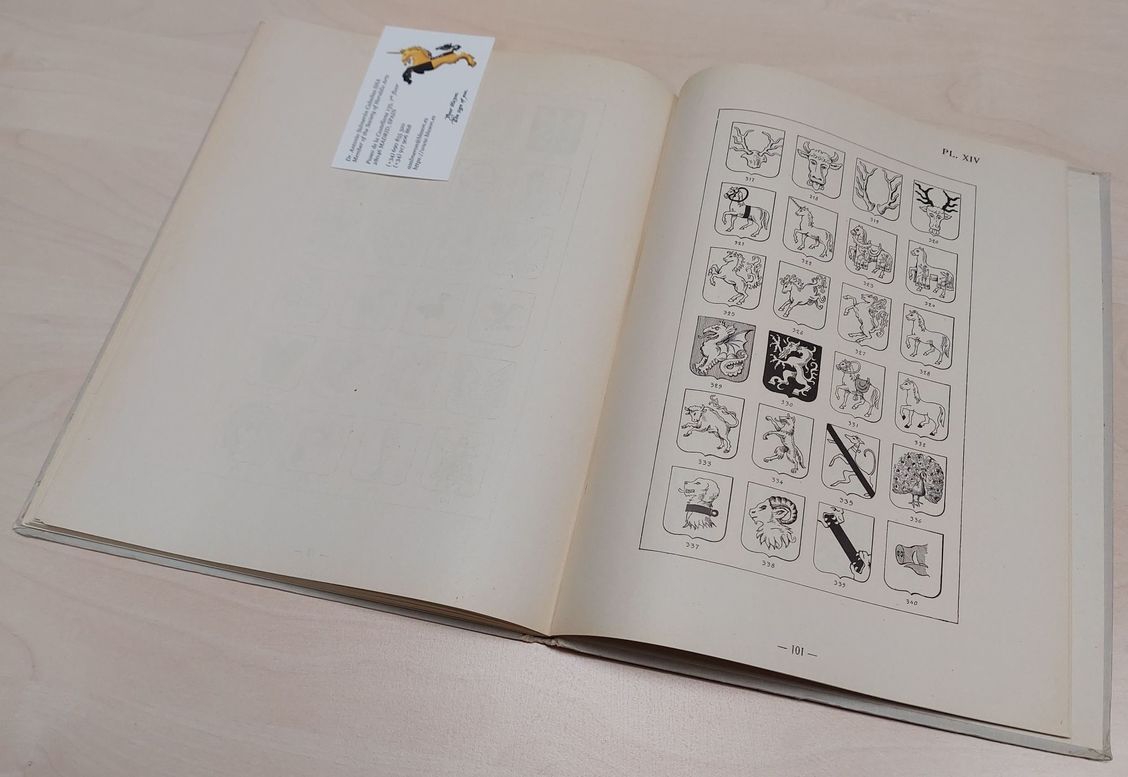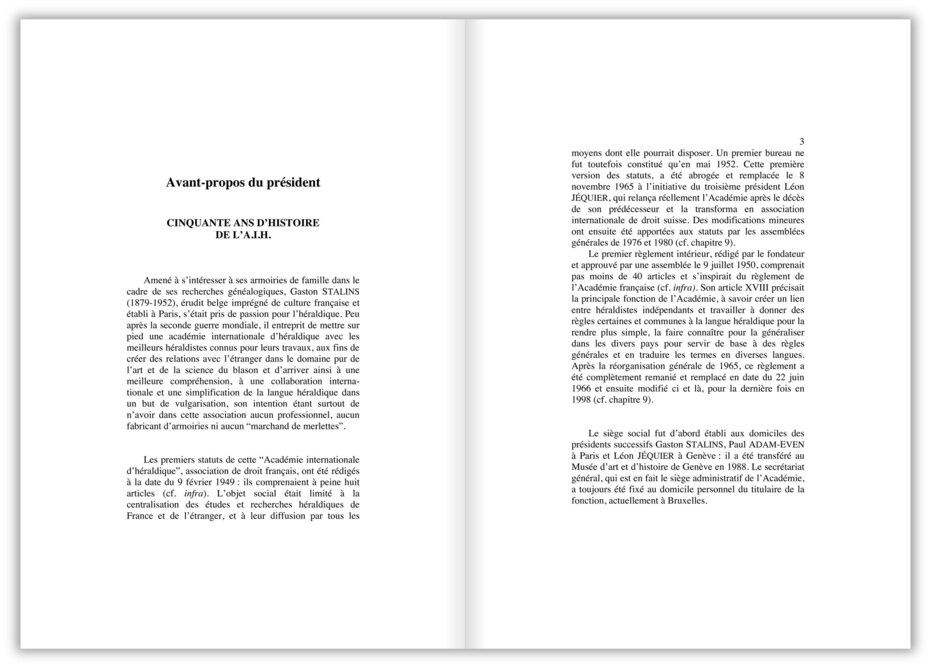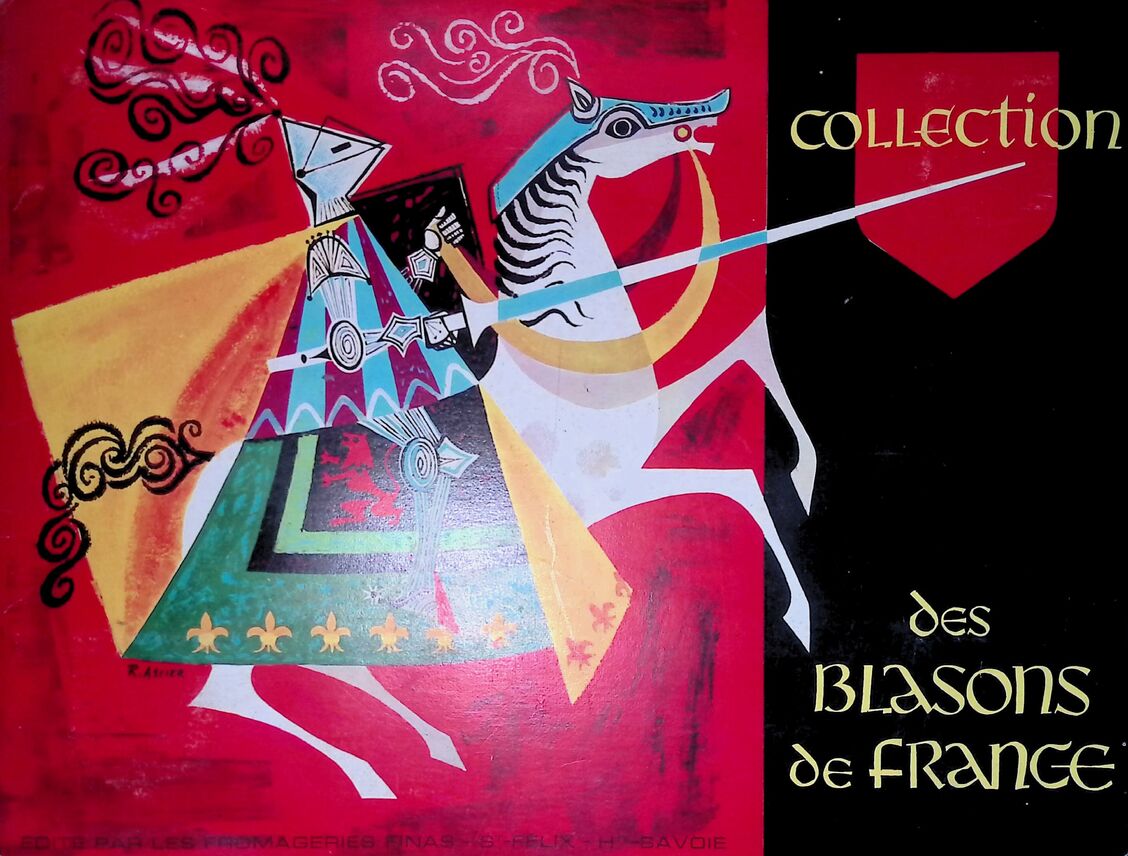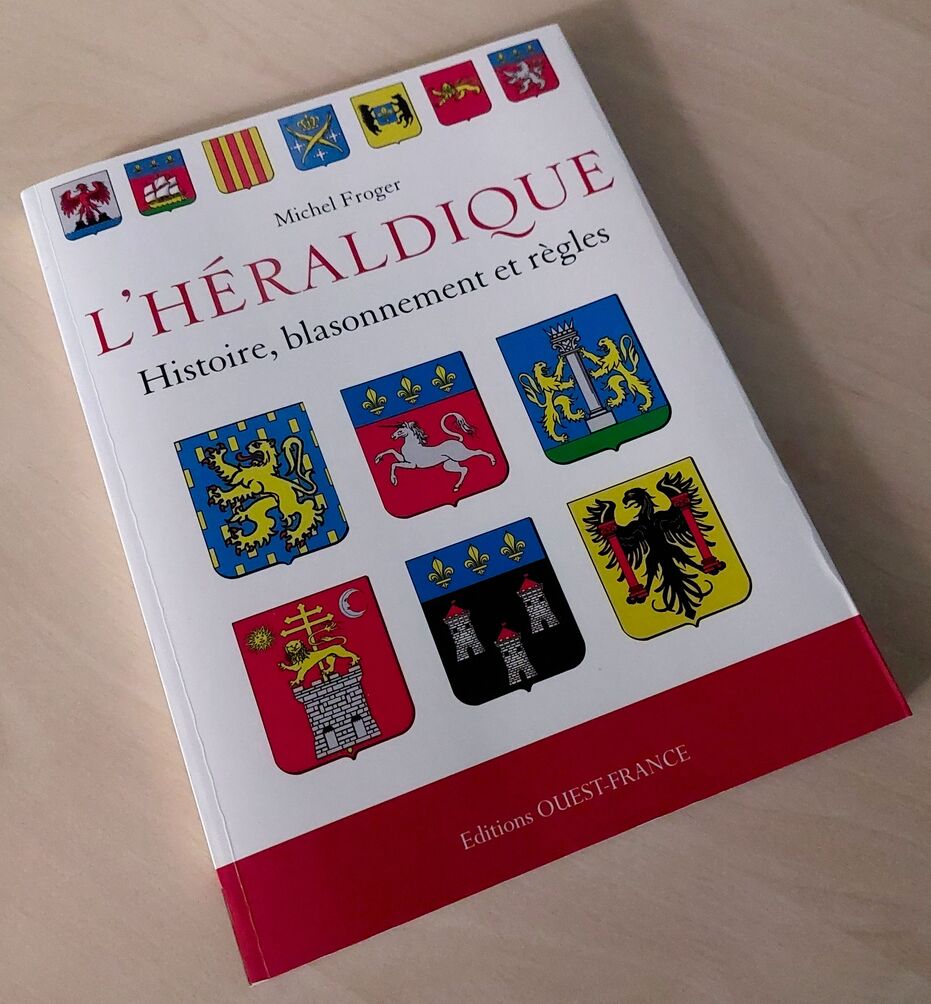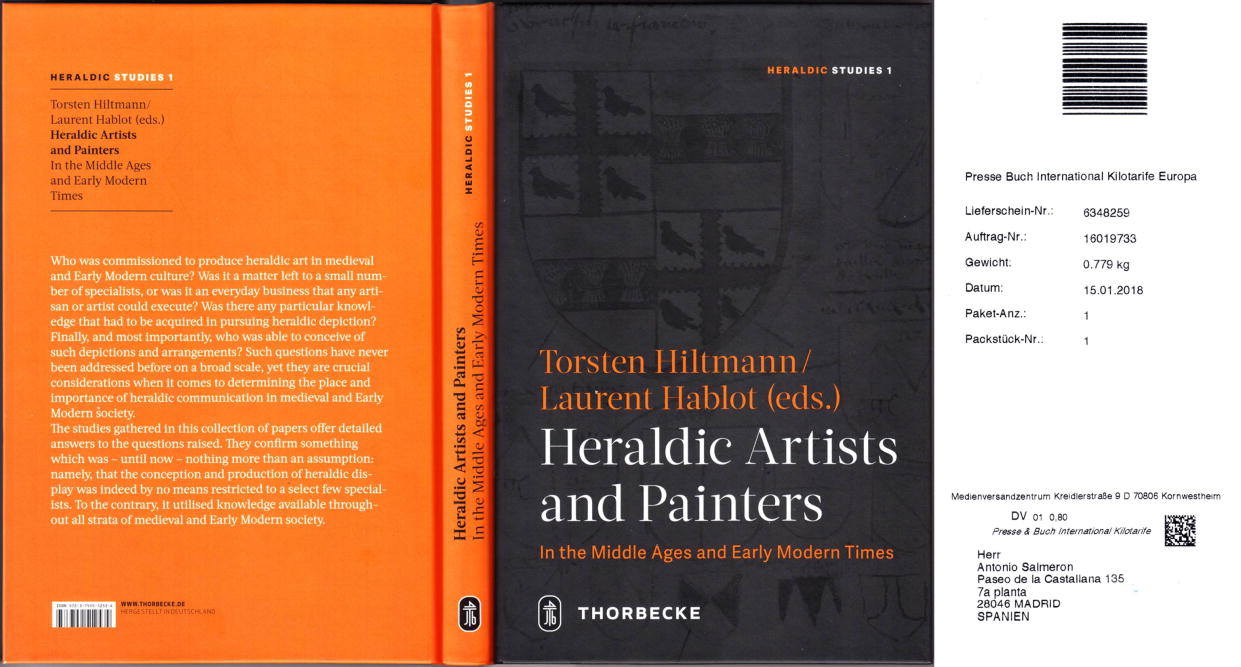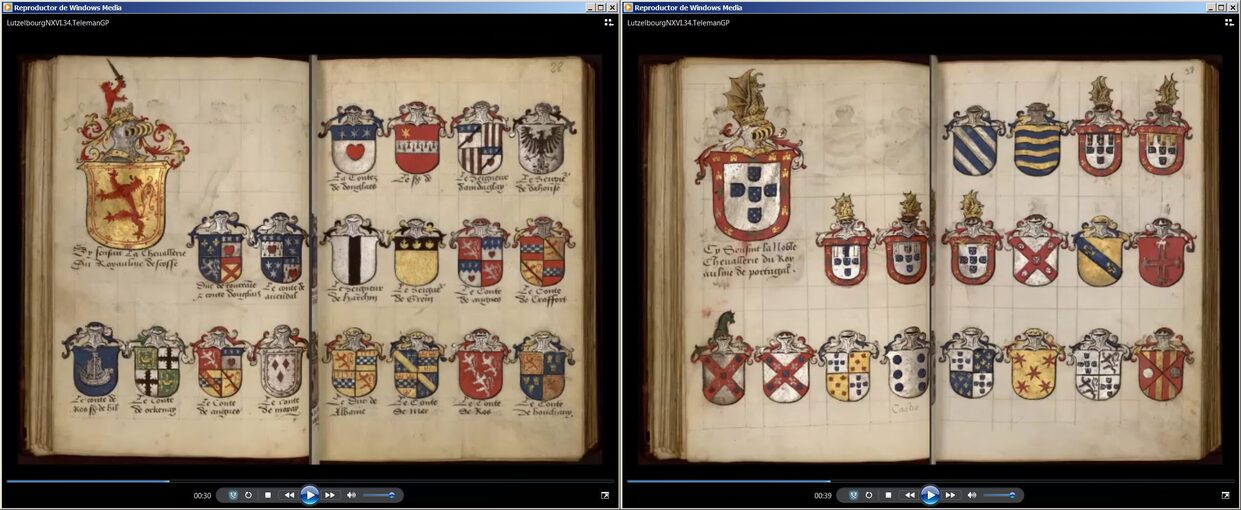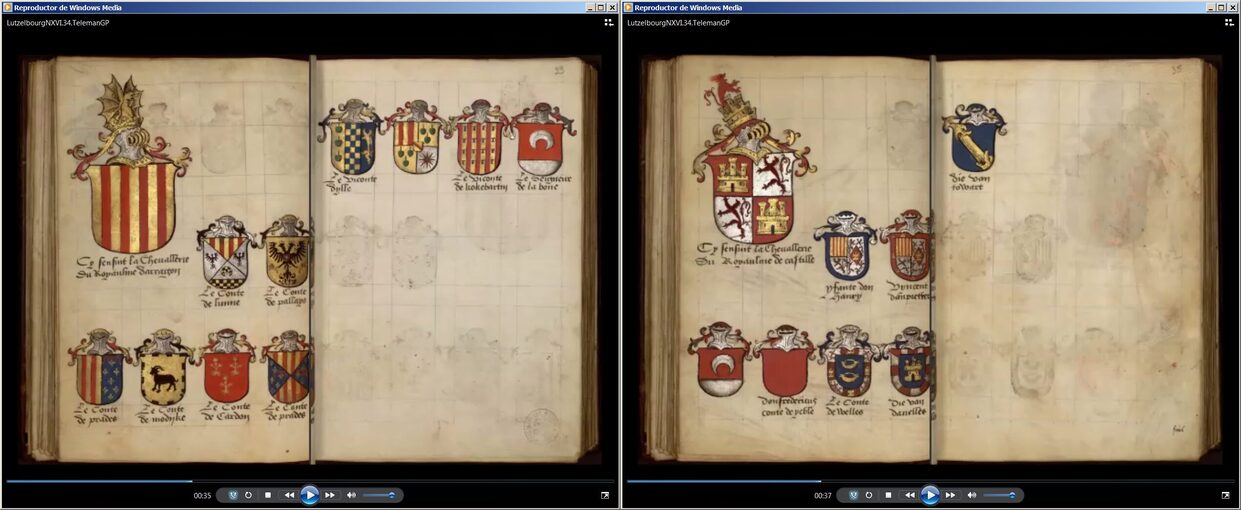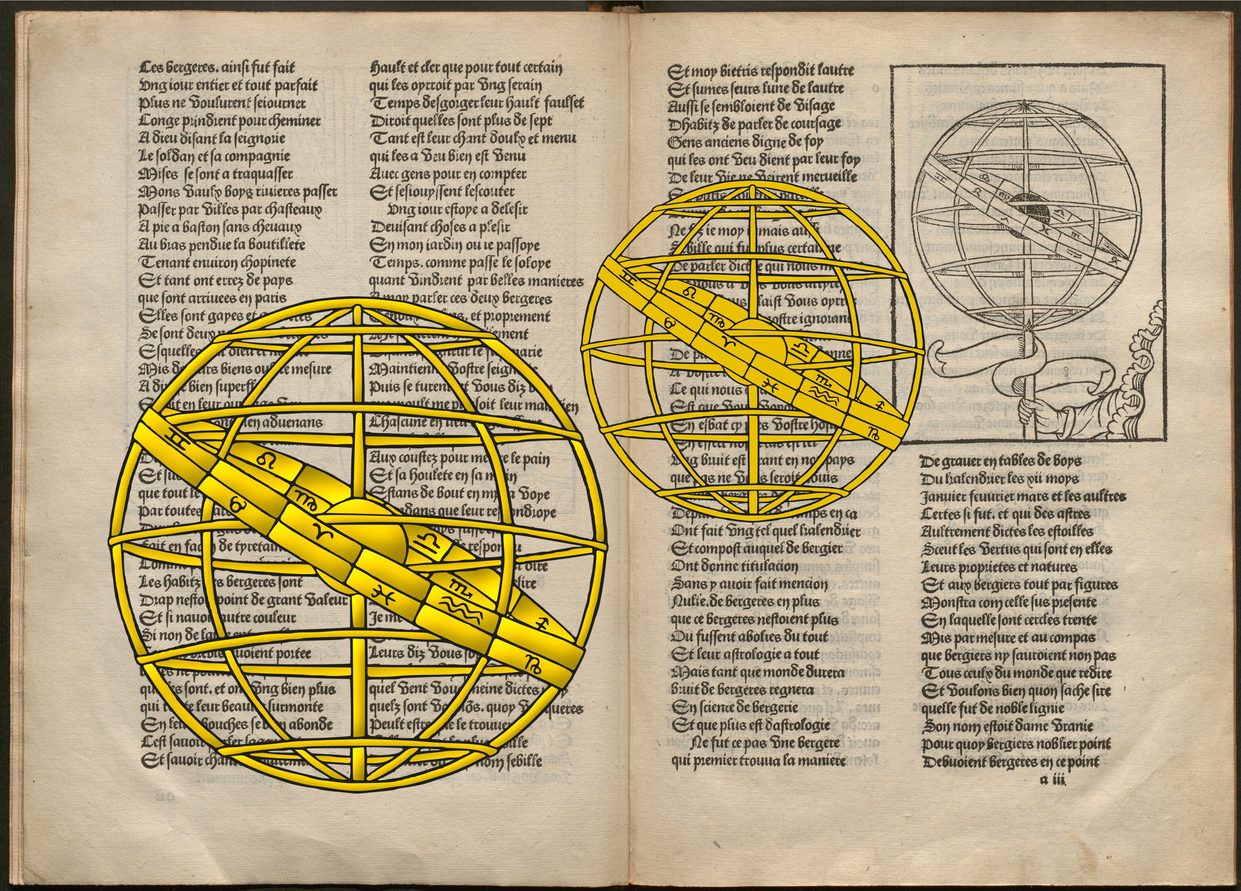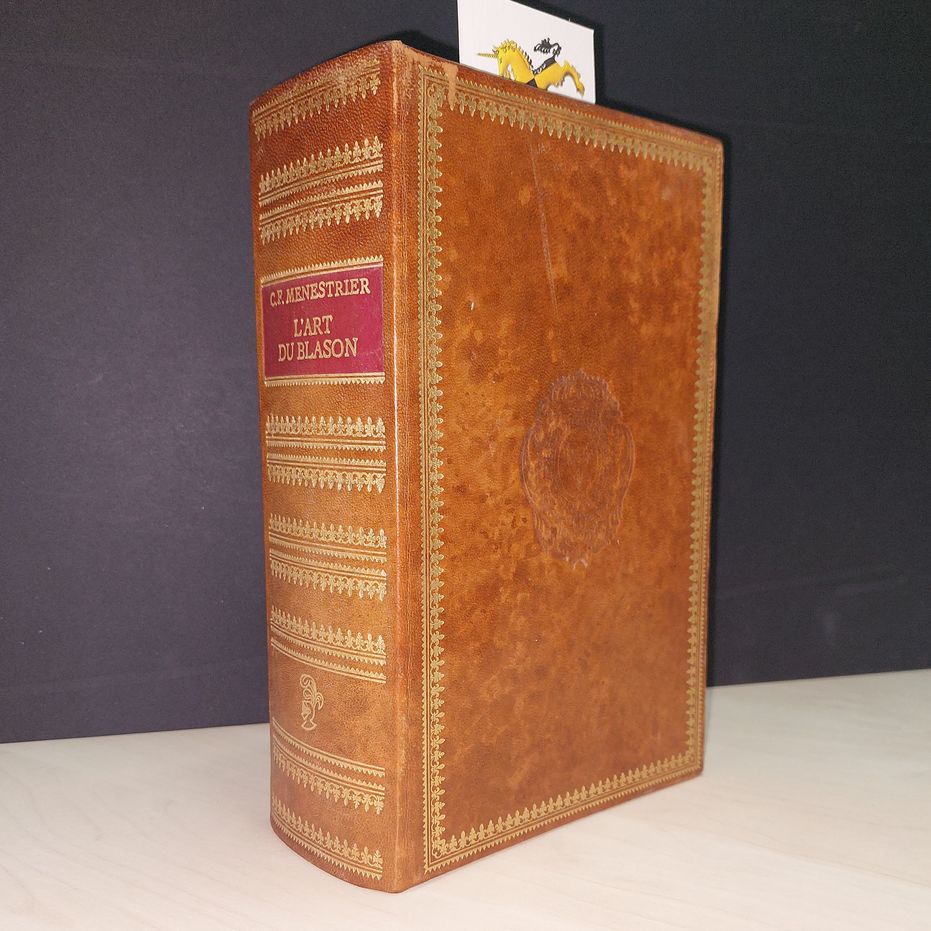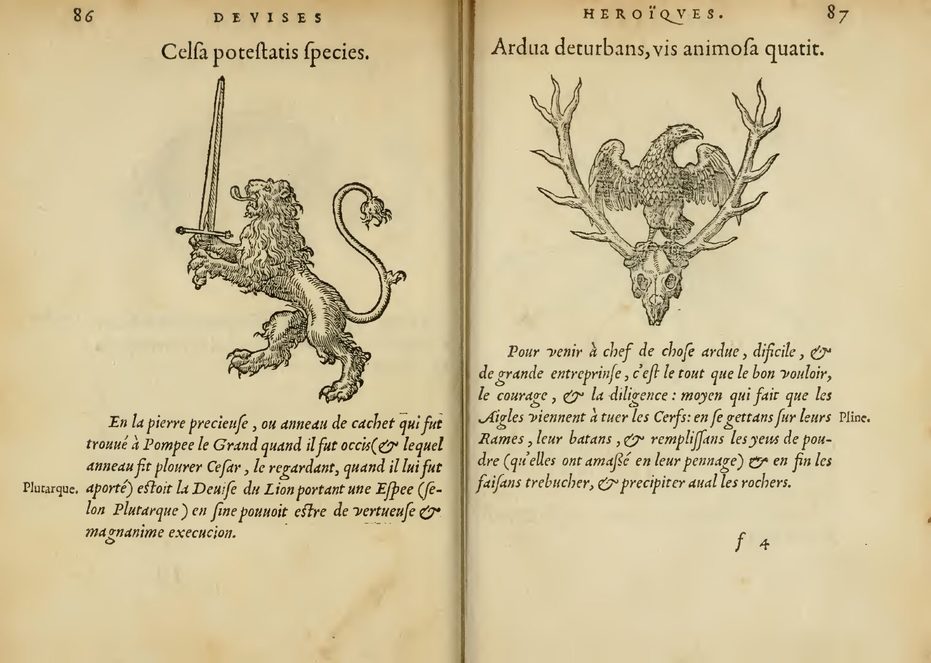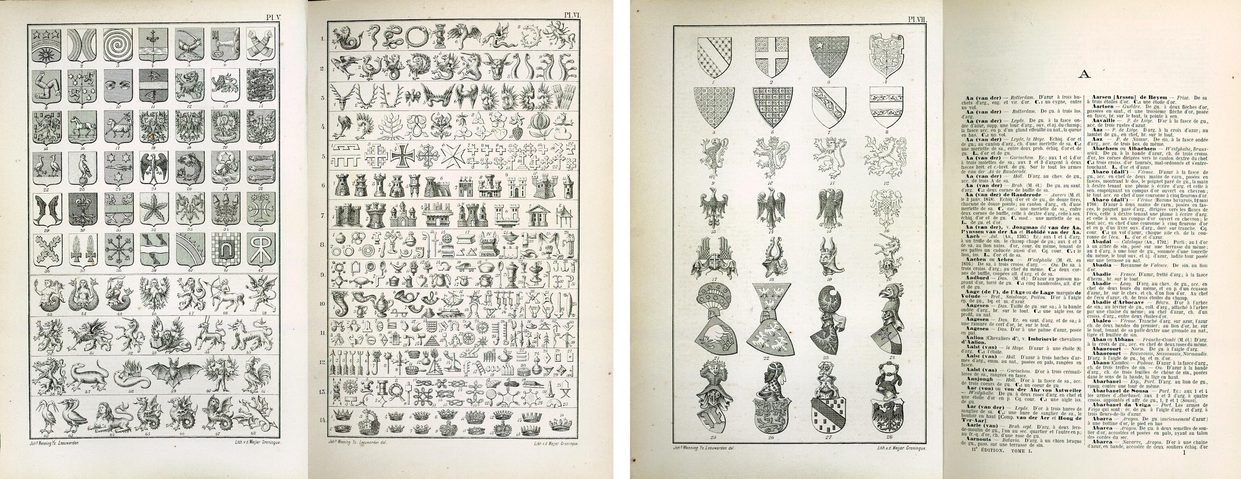French language


![Ver [Académie internationale d'héraldique; 1952] en referencias bibliográficas. Libro abierto, hojas de plata, filo de oro, guardas de gules, tapas de sable.](../css/Libro.Bibliografia.png)
Académie internationale d'héraldique; 1952
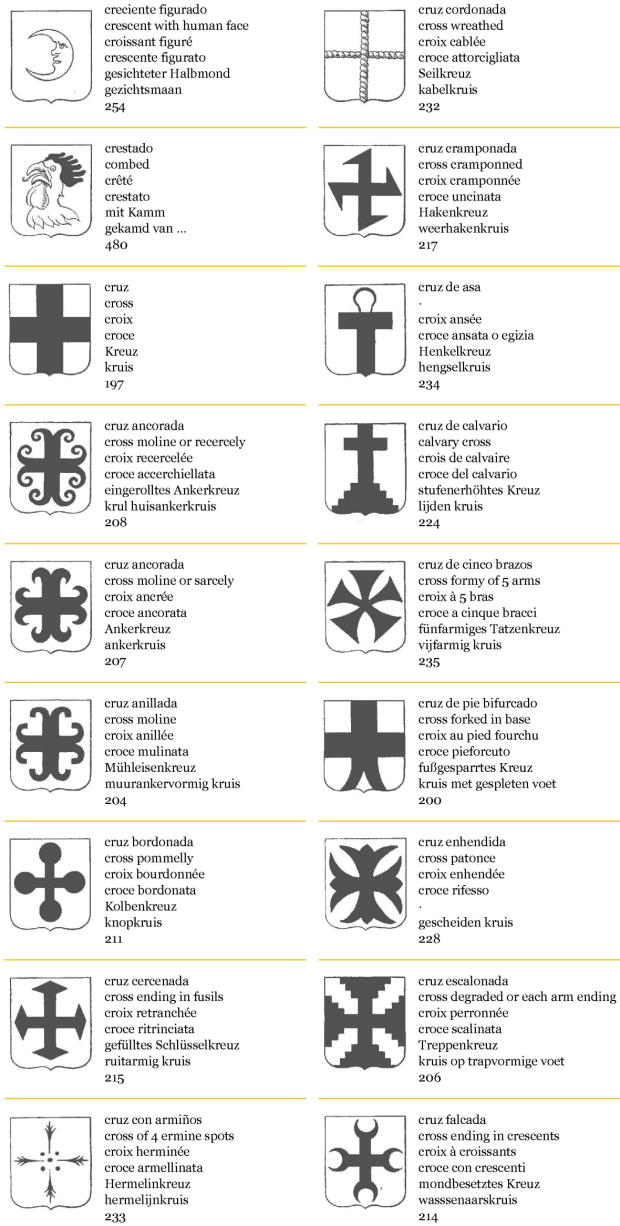
Académie internationale d'héraldique, AIH, «Vocabulaire-Atlas Héraldique en six Langues: Francais - English - Deutsch - Español - Italiano - Nederlandsch», by Gaston Stalins, Le Baron Stalins, with the collaboration of René Le Juge De Segrais, Ottfried Neubecker, Martin de Riquer y Morera, Giacomo Carlo Bascapé, and Mario Gorino-Causa, 119 pages, 530 black and white heraldic pictures, Société du Grand Armorial de France, 179 Boulevard Haussmann, París, 1952.
This book begins with the following sentence: «Heraldique - science et art - qui prit naissance en France vers la moitié du XIIe siècle, s'est propagée très rapidement dans les principaux pays européens».
The number of terms and words of the heraldry by languages is as follows:
- French language: 523 heraldic terms.
- Dutch language: 521 heraldic terms.
- German language: 519 heraldic terms.
- Spanish language: 511 heraldic terms.
- Italian language: 506 heraldic terms.
- English language: 502 heraldic terms.
The names of the authors and collaborators have been checked with [Académie internationale d'héraldique; 1999].
Its 530 heraldic illustrations correspond, according to my calculations to 509 drawings, numbered from 1 to 530. Some images contain several numbers, for example, the image that shows a coat of arms with its mantling, number 528, and its supporters, number 529, a griffin and a lion rampant, it is the same illustation, but with 2 numbers.
Bibliographical reference of century XXI.
Classification: Dictionary, French language, English language, German language, Castilian language, Italian language and Dutch language.
Authors:
- Stalins, Gaston.
- Le Juge De Segrais, René.
- Neubecker, Ottfried.
- Riquer y Morera, Martin de.
- Bascapé, Giacomo Carlo.
- Gorino-Causa, Mario.
The following articles cite this bibliographic reference:
- Ermine
- Ixai Lanzagorta Ochoa, plain tincture
- Pile issuant from the base in the Dictionary of the Spanish Language
- Sanz Lacorte, J.; 2007
- Sir Thomas Grenville II
- Val'Quirico, wreath an owl
External resource:
Internal resources: Aih1952.00.Vocabulaire.Original.pdf, Aih1952.01.Vocabulaire.Sefidn.pdf and Paper edition with a Swedish bookplate.


![Ver [Académie internationale d'héraldique; 1999] en referencias bibliográficas. Libro abierto, hojas de plata, filo de oro, guardas de gules, tapas de sable.](../css/Libro.Bibliografia.png)
Académie internationale d'héraldique; 1999
Académie internationale d'héraldique, AIH, «Mémorial du Jubilé, 1949-1999», 201 páginas, 1999.
Bibliographical reference of century XX.
Classification: Report and French language.
The author is Académie internationale d'héraldique.
Bibliographical reference mentioned in the following article:
External link:
Internal resources: Aih1999.Memorial.pdf.


![Ver [Cramer, R. de; 1913] en referencias bibliográficas. Libro abierto, hojas de plata, filo de oro, guardas de gules, tapas de sable.](../css/Libro.Bibliografia.png)
Cramer, R. de; 1913
René de Cramer, «Drapeaux, Bannières, Vlaggen en Wimpels», Universal and International Exhibition of Ghent 1913, La Vieille Flandre, published by Société Anonyme Belge d'Imprimerie, Brussels, 1913.
Bibliographical reference of century XX.
Classification: French language, Dutch language and Black and white with color plates.
The author is Cramer, René de.
Internal resources: CramerRde913.DrapeauxBannir.docx.


![Ver [Finas, F.; 1950] en referencias bibliográficas. Libro abierto, hojas de plata, filo de oro, guardas de gules, tapas de sable.](../css/Libro.Bibliografia.png)
Finas, F.; 1950
Fromageries Finas, «Collection des blasons de France. 1st Edition», «Collection des blasons de France. 2nd Edition», 23 pages, illustrated by Jean Brian, cover signed by R. Assier, published by Fromageries Finas, Saint-Félix, Haute-Savoie, circa 1950.
The «Collection des blasons de France» collections include two editions: the first edition with 50 coats of arms from French provinces and the second edition with 100 coats of arms from the main cities of France.
Each coat of arms was included in the packaging of Finas spreadable cheeses. The albums were available upon request for 10 postage stamps to cover handling costs.
These albums are an excellent example of how brands used heraldry to create an emotional and educational connection with their customers, employing coats of arms to reinforce a sense of identity and tradition, as can be seen in the index of the 1st edition.
Index of the 1st edition, coat of arms and page:
- Alsace 8
- Angoumois 12
- Anjou 10
- Armagnac 14
- Artois 4
- Aunis 12
- Auvergne 16
- Bar 8
- Béarn 14
- Beaujolais 6
- Berry 12
- Bourbonnais 6
- Bourgogne 6
- Bresse 6
- Bretagne 10
- Champagne 8
- Charolais 6
- Comtat-Venaissin 18
- Corse 18
- Dauphiné 18
- Flandre 4
- Foix 14
- Forez 16
- Franche-Comté 8
- Gascogne 14
- Guyenne 14
- Ile-de-France 4
- Languedoc 16
- Limousin 12
- Lorraine 8
- Lyonnais 6
- Maine 10
- Marche 12
- Maurienne 18
- Navarre 14
- Nice 18
- Nivernais 6
- Normandie 10
- Orléanais 10
- Picardie 4
- Poitou 12
- Provence 18
- Quercy 14
- Roussillon 16
- Saintonge 12
- Savoie 18
- Touraine 10
- Valois 4
- Vermandois 4
- Vivarais 16
Bibliographical reference of century XX.
Classification: Armorial roll, French language and In color.
The author is Finas, Fromageries.
Internal resources: FinasF1950.01.Edition.pdf Digital PDF version of the 1st Edition and FinasF1950.02.Edition.pdf Digital PDF version of the 2nd Edition.


![Ver [Froger, M.; 2012] en referencias bibliográficas. Libro abierto, hojas de plata, filo de oro, guardas de gules, tapas de sable.](../css/Libro.Bibliografia.png)
Froger, M.; 2012
Michel Froger, «L'héraldique: histoire, blasonnement et règles», 127 pages, more than 1000 color illustrations, Editions Ouest-France, ISBN.13 9782737357923, Rennes, 12 September 2012.
Bibliographical reference of century XXI.
Classification: In color and French language.
Author: Froger, Michel.
Internal resources: Paper edition, gifted by the author.


![Ver [Gourdon de Genouillac, H.; 1889] en referencias bibliográficas. Libro abierto, hojas de plata, filo de oro, guardas de gules, tapas de sable.](../css/Libro.Bibliografia.png)
Gourdon de Genouillac, H.; 1889
Henri Gourdon de Genouillac, «L'Art Héraldique», part of the series Bibliothèque de l'enseignement des Beaux-arts, published under the direction of M. Jules Comte, Maison Quantin, 290 pages, 21 centimeters, Paris, 1889.
With some black and white small illustrations, it covers the art of heraldry, its history, rules, and applications, and serves as a comprehensive guide for artists, historians, and those interested in the heraldic art.
Contents
- Chapter I. The blazon - Pieces and figures that compose coats of arms, page 11.
- Chapter II. Repertoire of attributes, page 98.
- Chapter III. External ornaments of the shield, their use, and their misuse, page 145.
- Chapter IV. Municipal arms, page 188.
- Chapter V. The blazon in the arts, page 200.
- Chapter VI. Blazoned garments, page 207.
- Chapter VII. Seals, tokens, méreaux of corporations, communities, page 214.
- Chapter VIII. The fleur-de-lis, the eagle, the lion, the leopard, various figures, page 222.
- Chapter IX. The blazon in England, Germany, and other nations, page 230.
- Chapter X. Explanatory glossary, page 252.
- Chapter XI. Heraldic bibliography, page 275.
Bibliographical reference of century XIX.
Classification: French language and In black and white.
The author is Gourdon de Genouillac, Henri.
The following article cites this bibliographic reference:
External resource:
Internal resources: GourdonDeGenouillacH1889.LArtHeraldique.pdf PDF version..


![Ver [Hiltmann, T.; Hablot, L.; et alii; 2018] en referencias bibliográficas. Libro abierto, hojas de plata, filo de oro, guardas de gules, tapas de sable.](../css/Libro.Bibliografia.png)
Hiltmann, T.; Hablot, L.; et alii; 2018
Torsten Hiltmann, Laurent Hablot, Marc Gil, Matteo Ferrari, Luisa Gentile, Oliver Fearon, Andreas H. Zajic, Martin Roland, Steen Clemmensen, Radu Lupescu, Anne-Sophie Bessero-Lagarde, Tanja Jones, Alessandro Savorelli and Jean-Christophe Blanchard, «Heraldic Artists and Painters in the Middle Ages and Early Modern Times», colection Heraldic Studies, volume 1, 236 pages, with illustrations and photographs in black and white and color, edition with some articles in English and other in French, dimensions 16.90 x 2.00 x 24.40 centimeters, edited by Torsten Hiltmann and Laurent Hablot, publication funded by the Volkswagen Foundation, by the 4th Section of the EA SAPRAT (Ecole Pratique des Hautes Etudes-Paris Sciences et Lettres) and by the CESCM (Centre d’Études Supérieures de Civilisation Médiévale de Poitiers), published by Jan Thorbecke Verlag, ISBN 978-3799512534, Ostfildern, Germany, 2018.
The content of this book is as follows:
Introduction
«Arms and Art in the Middle Ages; Approaching the Social and Cultural Impact of Heraldry by its Artisans and Artists», article in English, pages 11-23, Torsten Hiltmann, Munich, Germany.
«Art, Esthétique et Productions Héraldiques au Moyen Âge; Considération Générales», article in French, pages 24-40, Laurent Hablot, Paris, France.
The artist
«Peinture d’Armoiries, une Activité Parmi d’Autres du Peintre Médiéval?», article in French, pages 43-55, Marc Gil, Lille, French Flanders, France.
«Au Service de la Commune; Identité et Culture des Peintres Héraldistes dans les Villes Italiennes aux XIIIème–XIVème Siècles», article in French, pages 56-75, Matteo Ferrari, Poitiers, France.
«Artistes, Hérauts et Héraldique de Part et d’Autre des Alpes Occidentales», article in French, pages 76-94, Luisa Gentile, Turin, Italy.
Conception
«As Yt Ys Made; Gender and Description in Plans for Armorial Displays by the English Gentry c. 1460–1500», article in English, pages 97-112, Oliver Fearon, York, United Kingdom.
«The Influence of Beneficiaries on the Artistic Make-up of Imperial Grants of Arms or: How Do Heraldic Images Get into Late Medieval Charters?», article in English, pages 113-132, Andreas H. Zajic, Vienna, Austria.
Specific supports and contexts
«Medieval Grants of Arms and their Illuminators», article in English, pages 135-155, Martin Roland, Vienna, Austria.
«Armorials as Commercial Ventures?», article in English, pages 156-166, Steen Clemmensen, Farum, Denmark.
«Heraldic Commissions in an Architectural Context; Case Studies from Transylvania», article in English, pages 167-178, Radu Lupescu, Cluj-Napoca, Romania.
«Les Auteurs des Pompes Funèbres Héraldiques à la Renaissance; Artistes de Renom, Associations de Peintres et Ateliers Spécialisés», article in French, pages 179-189, Anne-Sophie Bessero-Lagarde, Paris, France.
Individual artists and their work
«Vivified Heraldry; On Pisanello’s Medallic Imagery», article in English, pages 193-206, Tanja Jones, Tuscaloosa, Alabama, United States.
«L’Héraldique des Della Robbia à Florence entre Abstraction et Naturalisme», article in French, pages 207-221, Alessandro Savorelli, Florence, Italy.
«Georges Gresset, Peintre et Héraut d’Armes des ducs de Lorraine, 1523–1559», article in French, pages 221-235, Jean-Christophe Blanchard, Nancy, France.
Bibliographical reference of century XXI.
Classification: English language, French language and Black and white and color illustrations.
Authors:
- Hiltmann, Torsten.
- Hablot, Laurent.
- Gil, Marc.
- Ferrari, Matteo.
- Gentile, Luisa.
- Fearon, Oliver.
- Zajic, Andreas H..
- Roland, Martin.
- Clemmensen, Steen.
- Lupescu, Radu.
- Bessero-Lagarde, Anne-Sophie.
- Jones, Tanja.
- Savorelli, Alessandro.
- Blanchard, Jean-Christophe.
External link:
Internal resources: Paper book.


![Ver [Lainé, P. L.; Lainé, J. J. L.; 1828] en referencias bibliográficas. Libro abierto, hojas de plata, filo de oro, guardas de gules, tapas de sable.](../css/Libro.Bibliografia.png)
Lainé, P. L.; Lainé, J. J. L.; 1828
P. Louis Lainé, J. J. L. Lainé, «Archives généalogiques et historiques de la noblesse de France, ou, Recueil de preuves, mémoires et notices généralogiques, servant à constater l'origine, la filiation, les alliances et lés illustrations religieuses, civiles et militaires de diverses maisons et familles nobles du royaume; Avec la collection des nobiliaires généraux des provinces de France», 11 volumes from 1828 to 1850, published by M. Lainé, printed by De Hauquelin et Dautriche, París, 1844.
Bibliographical reference of century XIX.
Classification: French language and In black and white.
The 2 authors are Lainé, P. Louis and Lainé, J. J. L..
External resources:
- Google books, Volume I, 1828.
- Google books, Volume II, 1829.
- Google books, Volume III, 1830.
- Google books, Volume IV, 1834.
- Google books, Volume V, 1836.
- Google books, Volume VI, 1839.
- Google books, Volume VII, 1841.
- Google books, Volume VIII, 1843.
- Google books, Volume IX, 1844.
- Google books, Volume X, 1846.
- Google books, Volume XI, 1850.


![Ver [Lutzelbourg, N. de; 1530] en referencias bibliográficas. Libro abierto, hojas de plata, filo de oro, guardas de gules, tapas de sable.](../css/Libro.Bibliografia.png)
Lutzelbourg, N. de; 1530
Nicolas de Lutzelbourg, lord of Fléville and captain of Nancy, «Roll of arms», sixteenth century (the author lived between 1485? and 1547), manuscript in French on parchment, with 230 pages numbered later with pencil the odd pages from 1 to 115, 29 x 21 cm, Bibliothèque-Médiathèque of Nancy digitized, source of the images with open license.
Video of 120 seconds composed for the Biblioteca Genealógica, Heráldica y Nobiliaria. Music by Georg Philipp Telemann (1681, 1767), Concerto for 4 Violins No. 2, TWV 40: 202, II. Grave, interpreted by Viola Viva, with Creative Commons license of Attribution and ShareAlike.
Content examples: Scotland on pages 28, 29 and 30 with 61 coat of arms; Aragon on page 33 with 11 coat of arms; Castile and Leon on page 35 with 8 coat of arms; Navarre on page 36 with 1 coat of arms; and Portugal on pages 37 and 38 with 27 coat of arms.
Bibliographical reference of century XVI.
Classification: Manuscript, Armorial roll, French language and In color.
Author: Lutzelbourg, Nicolas de.
Bibliographic reference mentioned in the following articles:
External resources:
- Manuscript's record in the Bibliothèque-Médiathèque of Nancy.
- Manuscript's pages in the Bibliothèque-Médiathèque of Nancy.


![Ver [Marchant, G.; 1499] en referencias bibliográficas. Libro abierto, hojas de plata, filo de oro, guardas de gules, tapas de sable.](../css/Libro.Bibliografia.png)
Marchant, G.; 1499
Guy Marchant, printer, «Compost et Kalendrier des Bergères», 68 folio leaves, more than 80 woodcut illustrations, Paris, August 17th, 1499.
This work complements the «Kalendrier des Bergiers» (1491), intended for a male audience, while this «Compost» is aimed at women readers, «Calendar of the Shepherdesses». Both books combine astrology, medicine, Christian morality, and practical advice. It includes numerous didactic woodcuts.
The image shows a golden armillary sphere, to be used in one of the versions of the coat of arms of Jean-Christophe Loubet del Bayle, extracted by me from one of the astrological pages of this book, page 15, «a iii».
In [Fernández de Enciso, M.; 1519; page 1] there is also an armillary sphere that bears certain similarities to the one appearing in [Marchant, G.; 1499; page 15]. A comparison of the bands with zodiac symbols of both spheres can be seen in [Fernández de Enciso, M.; 1519].
Bibliographical reference of century XV.
Classification: In black and white, French language and Incunabulum.
The author is Marchant, Guy.
Here are the articles quoting this reference:
External resources:
- Historical Library of Marquis of Valdecilla.
- Catalogue entry and full text.
- In the Digital Heritage of the Complutense University of Madrid.
Internal resources: MarchantG1499.CompostEtKalendrierDesBergeres.UCM.pdf, scanned PDF version from the Historical Library of the Complutense University of Madrid.


![Ver [Menestrier, C. F.; 1659] en referencias bibliográficas. Libro abierto, hojas de plata, filo de oro, guardas de gules, tapas de sable.](../css/Libro.Bibliografia.png)
Menestrier, C. F.; 1659
Claude-François Menestrier, member of the Society of Jesus, «Le veritable art du blason et la pratique des Armoiries depuis leur Institution», «Auec Privilege du Roy»~avec le privilège du roi, 10 pages of introduction, 415 pages of content, 14 pages of indexes and 339 pages in total, Chez Benoît Coral, ruë Merciere à la Victoire, Lyon, 1659.
Bibliographical reference of century XVII.
Classification: In black and white and French language.
Author: Menestrier, Claude-François.
The following article cites this bibliographic reference:
External resource:


![Ver [Menestrier, C. F.; 1750] en referencias bibliográficas. Libro abierto, hojas de plata, filo de oro, guardas de gules, tapas de sable.](../css/Libro.Bibliografia.png)
Menestrier, C. F.; 1750
Claude-François Menestrier, member of the Society of Jesus, «La Nouvelle Methode Raisonnée du Blason pour l'Aprendre d'une Maniere Aisée: Reduite en Leçons par Demandes, Et par Réponses», «Auec Privilege du Roy» ~ with the privilege of the king, 298 pages accompanied by additional tables, Lyon, 1750.
Method
The central part of the book functions primarily as a dictionary, where heraldic terms are presented with the text of a blazon that contains them and the drawing of the blazon that illustrates them. The blazon illustrations are grouped on plates organized in a format of 5 rows and 5 columns, displaying 20 coats of arms per plate.
Facsimile edition details
This volume, produced by Vernoy for Arnaud de Vesgre, features a faithful and complete reproduction of the text and illustrations from the 1750 edition of the work by C. F. Menestrier. It was printed on 160-gram laid paper and bound in genuine hand-marbled leather as done in the past. The front cover and spine were stamped using a balance press with 22-carat fine gold. Printed in Switzerland by Idégraf, production by I.C.E.D., Arnaud de Vesgre, edition number 516, Legal deposit 1979 - 06.79.
Bibliographical reference of century XVIII.
Classification: In black and white, Dictionary and French language.
The author is Menestrier, Claude-François.
Internal resources: A facsimile edition as a physical book on paper.


![Ver [Osmont, C.; 1858] en referencias bibliográficas. Libro abierto, hojas de plata, filo de oro, guardas de gules, tapas de sable.](../css/Libro.Bibliografia.png)
Osmont, C.; 1858
Charles Osmont, «L'Art Heraldique Contenant La Maniere d ' Apprendre Facillement Le Blason, Enrichy Des Figures Necessaires Pour L' Intelligence Des Termes», bound in leather, raised bands, title label, 8 preliminary leaves, 291 pages, and 35 plates, Paris, 1715.
Bibliographical reference of century XIX.
Classification: French language and In black and white.
The author is Osmont, Charles.
Internal resources: Physical book on paper.

![Ver [Paradin, C.; 1557] en referencias bibliográficas. Libro abierto, hojas de plata, filo de oro, guardas de gules, tapas de sable.](../css/Libro.Bibliografia.png)
Paradin, C.; 1557
Claude Paradin, «Devises heroïqves», with woodcuts attributed to Bernard Salomon, published by Jean de Tournes and Guillaume Gazeau, second edition, first edition published in 1551, dedication dated January 15, 1556, 261 pages, Lyon, 1557.
Description
The book includes emblems that consist of a motto, mostly in Latin, with a few in French or Greek, a woodcut illustration, and an explanation in French. The emblems feature devices of kings and rulers, symbols from the Bible, classical history, and other sources.
The title page is framed within a grotesque ornamental border. The copy includes the signature of C.F. Lüdorf, handwritten, on the lower left corner of the title page verso. There is irregular pagination with misprinted page numbers, foxing, and narrow margins. The book does not include a table of contents.
Examples of the first mottos
- Nullis praefentior aether, page 7.
- Manet insontem grauis exitus, page 9.
- Secum seret omina mords, page 11.
- Hîc ratio tentandi aditus, page 12.
- Pignora cara sui, page 13.
- Animis illabere nostris, page 14.
- Fortuna fidem mutata nouauir, page 15.
- Nutrisco & extinguo, page 16.
- Monstrant Regibus astra viam, page 18.
- Donec totum impleat orbem, page 20.
- Immensi tremor Oceani, page 22.
- Vlcus auos Troix, page 25.
- Non sine causa, page 27.
- Plus outre, page 29.
- Imperium sine fine dedi, page 32.
- Inextricabilis error, page 34.
- Securitas altera, page 36.
- Dederit'ne viam casus'ue Deus'ue, page 38.
- Fortitudo eius Rhodum tenuit, page 39.
- Non inferiora secutus, page 41.
- Ance ferit, quam flamma micet, page 43.
- Precium non vile laborum, page 44.
Bibliographical reference of century XVI.
Classification: Symbolism, In black and white and French language.
The author is Paradin, Claude.
External resource:
Internal resources: ParadinC1557.DevisesHeroiqves.pdf PDF format.


![Ver [Rietstap, J. B.; 1861] en referencias bibliográficas. Libro abierto, hojas de plata, filo de oro, guardas de gules, tapas de sable.](../css/Libro.Bibliografia.png)
Rietstap, J. B.; 1861
Johannes Baptista Rietstap, «Armorial général, précedé d'un Dictionnaire des termes du blason», edited by Gerrit Benjamin van Goor, 2 volumes, Volume I from A to K, 1149 páginas, Volume II from L to Z, 1316 páginas, Gouda, 1861.
Bibliographical reference of century XIX.
Classification: French language.
The author is Rietstap, Johannes Baptista.
The following articles cite this bibliographic reference:
- Ackerson - Akers, lineage
- Amancier, lineage of Genevois
- Amitay Edward von Stiebel, collage
- Lineage Baldovino from Venecia, plain tincture
- Lineage Baldovino from Venecia, schema 2x2
- Malvin de Montazet, lineage of Languedoc
- Oschoven of the Rhin
- Talbot, lineage of England
- Urban V
External links:
- Deuxième édition refondue et augmentée, 1884-1887, volume I, A-K.
- Deuxième édition refondue et augmentée, 1884-1887, volume II, L-Z.
- Gerrit Benjamin van Goor.
Internal resources: RietstapJB1861.10.ArmorialGeneral.A.Z.txt in ASCII format in French with 126,068 blazons, RietstapJB1861.10.ArmorialGeneral.A.Z.doc in Word format in French, RietstapJB1861.11.ArmorialGeneral.A.K.pdf in PDF format in French, RietstapJB1861.12.ArmorialGeneral.L.Z.pdf in PDF format in French and physical book on paper, 2 volumes.


![Ver [Urfe; Century XV] en referencias bibliográficas. Libro abierto, hojas de plata, filo de oro, guardas de gules, tapas de sable.](../css/Libro.Bibliografia.png)
Urfe; Century XV
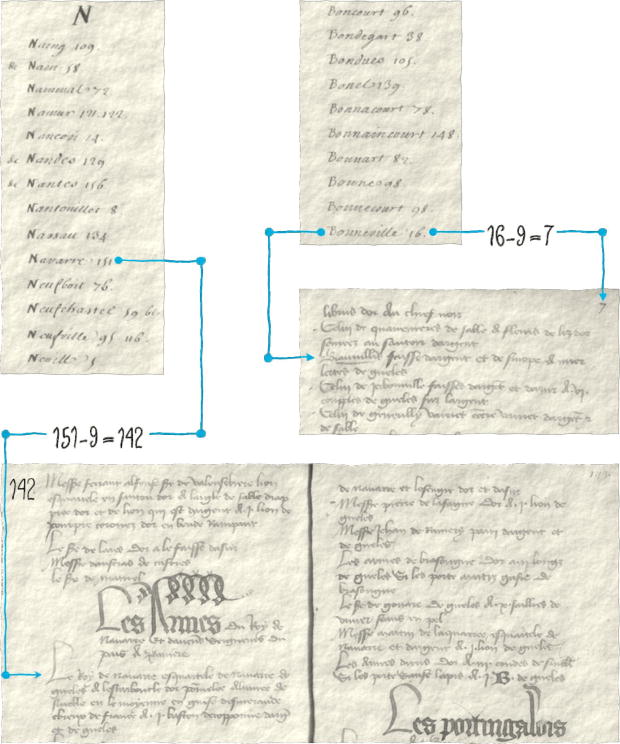
Urfé, unknown authors, «Urfe's Armorial», is currently in National Library of France (BnF, Bibliothèque nationale de France), in Paris, «Cabinet des titres» 927 as indicated on page I, cataloged with the code ms. fr. 32753, it is estimated from the XV century.
This armorial is written in French, on parchment measuring 19.5 x 14 centimeters, its compilation is believed to have been done in the 15th century, it presents 2,855 blazons in written form, but without illustrations, its blazons are organized into 54 sections, with an average of 17 blazons per page, the densest pages with about 20 blazons of 1, 2, or 3 lines per blazon, although some are longer. This Urfé armorial has served as a source for later armorials.
This manuscript contains a preliminary index, written later, of 61 pages, foliated the odd pages in consecutive Roman numerals from folio I to folio XXX. That is, 30 folios of 2 pages plus a final page, totaling 30 x 2 + 1 = 61 pages. This preliminary index consists of a name and a page number where the «theoretically», as will be explained below, corresponding blazon appears.
Next comes the true body of the Urfé armorial, of 162 pages, foliated only the odd pages, dated later than the compilation of the manuscript, in Arabic numerals, 2 by 2, from folio 1 to 161. That is, 1, 3, 5, 7, ..., 159, 161, and the last existing unnumbered page, as it is the 162nd which is even. I say that the 162nd is the last existing page because the National Library of France classifies it as an incomplete manuscript at the end.
It is a bit difficult to understand the relationship between the numbers that appear in the preliminary index, accompanying the names, and the numbering of the pages of the Urfé armorial. For example:
- Bouneville, which in the index appears with the number 16, is blazoned on page 7 (16 - 9 = 7).
- Navarre, for Navarra, in the index appears with the number 151, while the blazon of "Le Roy de Navarre" appears on page 142 (151 - 9 = 142).
This rule of subtracting 9, which has worked for me, but may not be of general use as, for example, Castille~Castile, on page VIII of the index, refers to page 140 of the content and it is there where it is actually found.
The Urfé armorial is in the public domain and the National Library of France, since February 23, 2012, has it published online with identification key ark:/12148/btv1b9063217v.
In this online version, as of today and until corrected, I believe that after page XIX, XVIII and XIX are repeated, just as folio 5 is repeated twice.
Bibliographical reference of century XV.
Classification: Armorial roll, Manuscript, In black and white and French language.
Author: unknown.
Bibliographical reference mentioned in the following article:
External resources:
-
Language
-
Categories of heraldry
-
Divisions of the field
- Without divisions
- Party per pale
- Party per fess
- Party per bend
- Party per bend sinister
- Tierce
- Tierce sinister
- Tierced per pale
- Tierced per fess
- Tierced per bend
- Tierced pallwise inverted
- Quarterly
- Quarterly per saltire
- Gyronny
- Party per fess, the chief per pale
- Party per pale, the sinister per fess
- Party per fess, the base per pale
- Party per pale, the dexter per fess
- Chapé
- Chaussé
- Embrassé
- Contre-embrassé
- Party per chevron
- Enté
- Enté en point
- Flanched
-
Metals
-
Colours
-
Furs
-
Other tinctures
-
Ordinaries and sub-ordinaries
-
Diminutives of the ordinaries
-
Geometric charges
-
Composite ordinaries
-
Inanimate charges from Nature
Atom, Crescent, Diamond, Emerald, Estoile, Increscent, Lightning flash, Moon, Mount, Mullet, Mullet of four points, Orbital, Plough of Ursa Major, Rainbow, Ray of the sun, River, Sea, Snowflake, Sun, Sun in splendour, Sun of May, Trimount, Water and Wave.
-
Vegetal charges from Nature
Acorn, Apple, Apple tree, Ash, Bluebonnet, Camellia, Chrysanthemum, Cinquefoil, Cornflower, Dogwood flower, Double rose, Elm, Fleur de lis, Flower, Gourd, Holm oak, Hop cone, Kapok tree, Laurel, Lily, Linden, Lotus flower, Madonna lily, Mexican cedar tree, Oak, Olive tree, Palm tree, Plantain plant, Pomegranate, Poplar leaf, Rose, Shamrock, Sunflower, Thistle, Tree, Tulip, Vine and Wheat.
-
Animal charges from Nature
Badger, Bald eagle, Barbel, Barn owl, Bear, Beaver, Beetle, Bighorn sheep, Blackbird, Boar, Brach hound, Bull, Doe, Dog, Dolphin, Dove, Eagle, Elephant, Falcon, Female figure, Fish, Flame, Fly, Fox, Frog, Goat, Goldfinch, Goose, Heron, Horse, Hummingbird, Jaguar, Lark, Leopard, Lion, Lion passant, Lion rampant guardant, Lioness, Lynx, Male figure, Martlet, Merino ram, Owl, Panther, Parrot, Peacock, Pelican, Pelican in her piety, Puffin, Quetzal, Raven, Roe deer, Rooster, Savage, Seagull, Serpent, She-wolf, Stag, Starling, Talbot, Tyger, Vulture, Warren hound and Wolf.
-
Parts of natural charges
Arm, Beak, Branch, Caboshed, Chest, Claw, Covert, Dorsal fin, Eagle claw, Ermine spot, Escallop, Feather, Foot (palmiped), Foreleg, Forepaw, Hand, Head, Heart, Hoof, Leaf, Neck, Ostrich feather, Palm frond, Paw, Roe deers' attires, Shoulder, Sprig, Stags' attires, Stem, Swallow-tail, Tail, Tail addorsed, Tail fin, Talon, Tooth, Trunk, Trunk (elephant), Two hands clasped, Two wings in vol, Udder, Wheat spike, Wing and Wrist.
-
Artificial charges
Ace of spades, Anchor, Anvil, Arch, Arm vambraced, Armillary sphere, Arrow, Axe, Bell, Bell tower, Beret, Bonfire, Book, Bookmark, Bow, Branding iron, Bridge, Broken, Buckle, Cannon, Cannon dismounted, Cannon port, Canopy roof, Carbuncle, Castle, Celtic Trinity knot, Chain, Chess rooks, Church, Clarion, Clay pot, Closed book, Club, Column, Comb, Compass rose, Conductor's baton, Cord, Covered cup, Crozier, Crucible, Cuffed, Cup, Cyclamor, Dagger, Double vajra, Drum, Ecclesiastical cap, Fanon, Federschwert, Fleam, Four crescents joined millsailwise, Galician granary, Garb, Gauntlet, Geometric solid, Grenade, Halberd, Hammer, Harp, Host, Hourglass, Key, Key ward, Knight, Knot, Lantern, Letter, Line, Loincloth, Menorah, Millrind, Millstone, Millwheel, Monstrance, Mortar, Mullet of six points pierced, Nail, Non-classic artifact, Norman ship, Number, Oar, Oil lamp, Open book, Page, Pair of scales, Parchment, Pestle, Piano, Pilgrim's staff, Plough share, Polish winged hussar, Port, Portcullis, Potent, Quill, Ribbon, Rosette of acanthus leaves, Sabre, Sackbut, Sail, Scroll, Scythe, Sheaf of tobacco, Ship, Skirt, Spear, Spear's head, Stairway, Star of David, Step, Sword, Symbol, Tetrahedron, Torch, Tower, Trident, Trumpet, Turret, Two-handed sword, Wagon-wheel, Water-bouget, Wheel, Winnowing fan and With a turret.
-
Immaterial charges
Angel, Archangel, Basilisk, Dragon, Dragon's head, Garuda, Golden fleece, Griffin, Heart enflamed, Justice, Mermaid, Our Lady of Mercy, Ouroboros, Paschal lamb, Pegasus, Phoenix, Sacred Heart of Jesus, Saint George, Sea-griffin, Trinity, Triton, Unicorn, Winged hand and Wyvern.
-
External elements
-
Heraldic creations
-
References
-
Formats
-
Keywords on this page
Armorial roll, Bibliography, Dictionary, In black and white, Black and white with color plates, Black and white and color illustrations, In color, Armillary sphere, Photographic, Genealogy, Incunabulum, German language, Castilian language, French language, English language, Italian language, Dutch language, Lineage, Manuscript, Report, Kingdom of France, Century XIX, Century XV, Century XVI, Century XVII, Century XVIII, Century XX, Century XXI, Symbolism and Video.

